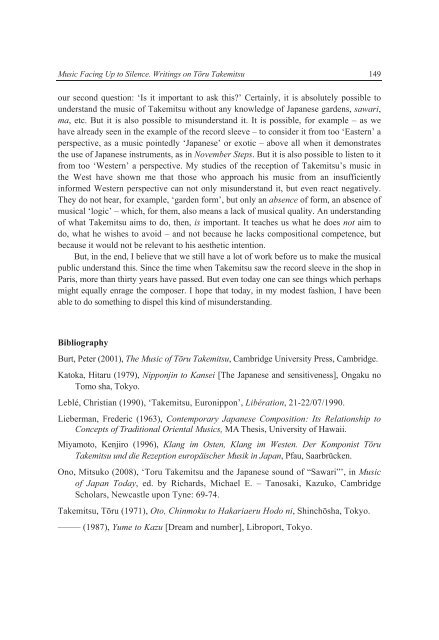Musica che affronta il silenzio - Scritti su Toru Takemitsu - Pavia ...
Musica che affronta il silenzio - Scritti su Toru Takemitsu - Pavia ...
Musica che affronta il silenzio - Scritti su Toru Takemitsu - Pavia ...
You also want an ePaper? Increase the reach of your titles
YUMPU automatically turns print PDFs into web optimized ePapers that Google loves.
Music Facing Up to S<strong>il</strong>ence. Writings on Tru Takemit<strong>su</strong><br />
our second question: ‘Is it important to ask this?’ Certainly, it is absolutely possible to<br />
understand the music of Takemit<strong>su</strong> without any knowledge of Japanese gardens, sawari,<br />
ma, etc. But it is also possible to mi<strong>su</strong>nderstand it. It is possible, for example – as we<br />
have already seen in the example of the record sleeve – to consider it from too ‘Eastern’ a<br />
perspective, as a music pointedly ‘Japanese’ or exotic – above all when it demonstrates<br />
the use of Japanese instruments, as in November Steps. But it is also possible to listen to it<br />
from too ‘Western’ a perspective. My studies of the reception of Takemit<strong>su</strong>’s music in<br />
the West have shown me that those who approach his music from an in<strong>su</strong>fficiently<br />
informed Western perspective can not only mi<strong>su</strong>nderstand it, but even react negatively.<br />
They do not hear, for example, ‘garden form’, but only an absence of form, an absence of<br />
musical ‘logic’ – which, for them, also means a lack of musical quality. An understanding<br />
of what Takemit<strong>su</strong> aims to do, then, is important. It tea<strong>che</strong>s us what he does not aim to<br />
do, what he wishes to avoid – and not because he lacks compositional competence, but<br />
because it would not be relevant to his aesthetic intention.<br />
But, in the end, I believe that we st<strong>il</strong>l have a lot of work before us to make the musical<br />
public understand this. Since the time when Takemit<strong>su</strong> saw the record sleeve in the shop in<br />
Paris, more than thirty years have passed. But even today one can see things which perhaps<br />
might equally enrage the composer. I hope that today, in my modest fashion, I have been<br />
able to do something to dispel this kind of mi<strong>su</strong>nderstanding.<br />
Bibliography<br />
Burt, Peter (2001), The Music of Tru Takemit<strong>su</strong>, Cambridge University Press, Cambridge.<br />
Katoka, Hitaru (1979), Nipponjin to Kansei [The Japanese and sensitiveness], Ongaku no<br />
Tomo sha, Tokyo.<br />
Leblé, Christian (1990), ‘Takemit<strong>su</strong>, Euronippon’, Libération, 21-22/07/1990.<br />
Lieberman, Frederic (1963), Contemporary Japanese Composition: Its Relationship to<br />
Concepts of Traditional Oriental Musics, MA Thesis, University of Hawaii.<br />
Miyamoto, Kenjiro (1996), Klang im Osten, Klang im Westen. Der Komponist Tru<br />
Takemit<strong>su</strong> und die Rezeption europäis<strong>che</strong>r Musik in Japan, Pfau, Saarbrücken.<br />
Ono, Mit<strong>su</strong>ko (2008), ‘<strong>Toru</strong> Takemit<strong>su</strong> and the Japanese sound of “Sawari”’, in Music<br />
of Japan Today, ed. by Richards, Michael E. – Tanosaki, Kazuko, Cambridge<br />
Scholars, Newcastle upon Tyne: 69-74.<br />
Takemit<strong>su</strong>, Tru (1971), Oto, Chinmoku to Hakariaeru Hodo ni, Shinchsha, Tokyo.<br />
––––– (1987), Yume to Kazu [Dream and number], Libroport, Tokyo.<br />
149

















